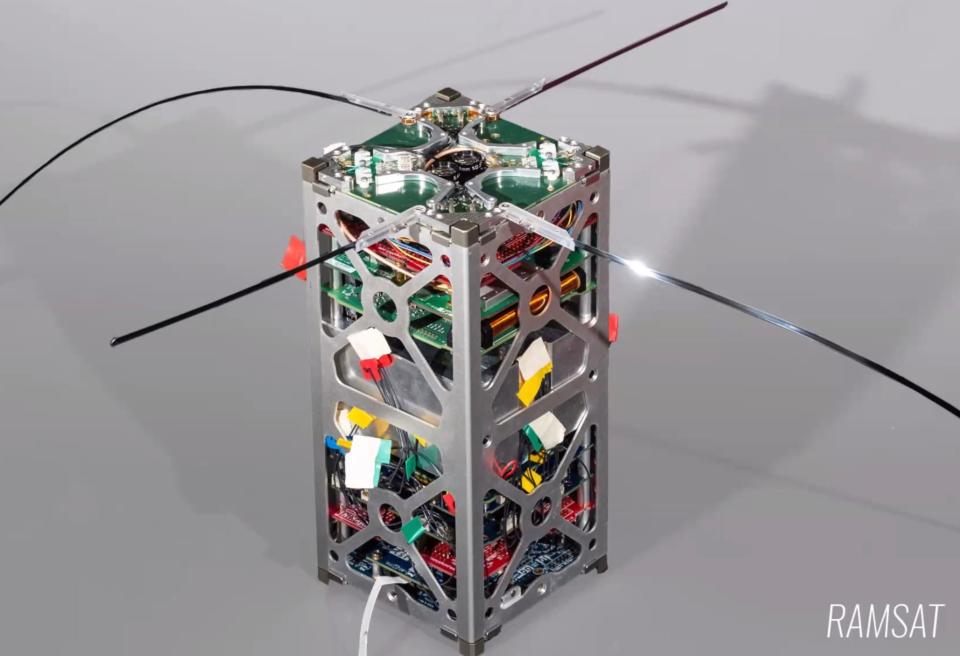RamSat taking photos while orbiting Earth

The middle school project to build a miniature satellite that is now taking photos from 250 miles above Earth was born around Christmas 2014. That’s when two men who first became friends years ago at Oak Ridge High School had a conversation at their Oak Ridge church.
They were Todd Livesay, a science and technology teacher at Robertsville Middle School (RMS), and Patrick Hull, an aeronautical engineer at NASA’s Marshall Space Flight Center in Huntsville, Ala. Hull suggested that the two work together on an educational project.
At first, Livesay resisted the idea and then ran with it after then RMS Principal Bruce Lay asked him to teach an engineering design enrichment class. His students enthusiastically produced miniature satellite frames in 2015 using the classroom’s 3D printer and wrote a computer program to open a payload door.

Then Livesay took them on a field trip to the Marshall Space Flight Center, where they gave a presentation on their work to Hull and others. Additional 3D-printed products and improved presentations to Hull followed.
The culmination of the student efforts, guided by mentors, was RamSat, a miniature “CubeSat” satellite named after the RMS mascot and now cruising in outer space. The story of RamSat and a progress report were presented recently by Livesay and three mentors during a public meeting of ORION, the local amateur astronomy organization.

Starting in 2016, mentors for the students were recruited from Oak Ridge National Laboratory and the Y-12 National Security Complex. Other recruits included parents and David Andrews, a ham radio operator.
Encouraged by Hull and other NASA employees, Livesay said, several students working with their mentors agreed to write a proposal to NASA to build a CubeSat, which measures under four inches on all sides and weighs less than three pounds. But first, they had to come up with a research mission. After a wildfire devastated forests around Gatlinburg in 2016, two students suggested using the satellite’s cameras to capture images of the damaged forests in the Great Smoky Mountains in a search for signs of regrowth. Hull liked the idea.
“Our proposal was approved and it came in second out of 26 proposals,” Livesay said. “The kids have worked hard on RamSat. They had to tear down the first RamSat when a chip burned out and then rebuild it. The school system has been cooperative concerning purchases of components. But the mentors have truly led this project.”
On June 3, 2021, six-and-a-half years after the Livesay-Hull reunion at Christmas during which 235 RMS students handled RamSat’s many components, the RMS CubeSat was launched by a SpaceX rocket from NASA’s Kennedy Space Center in Cape Canaveral, Fla. Some 24 hours later, RamSat reached the International Space Station (ISS).
On June 14, a robotic arm positioned a spring-loaded box outside the ISS. It contained RamSat and another miniature research satellite, called SOAR, built by the University of Manchester in England. After the two CubeSats were deployed in an orbit 250 miles above Earth, they separated.

Almost five months later, RamSat is still traveling about 17,000 miles per hour and making a complete orbit of Earth every 90 minutes. Its two cameras are snapping photographs of cloud-free areas of Earth. RamSat will remain in orbit for six to 12 more months and then burn up in the atmosphere as it falls toward Earth.
The good news is that RamSat and its components, worth $60,000, is working well and taking photos of regions of Earth’s surface. The costs were defrayed by donations from various organizations, including $15,000 from ORNL.

 Yahoo Autos
Yahoo Autos 